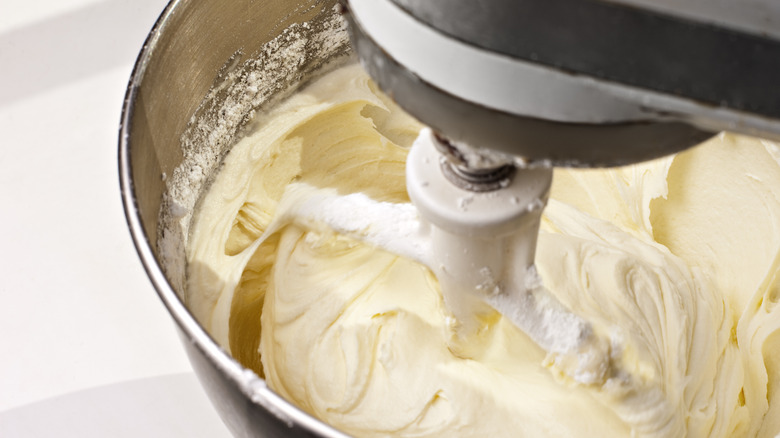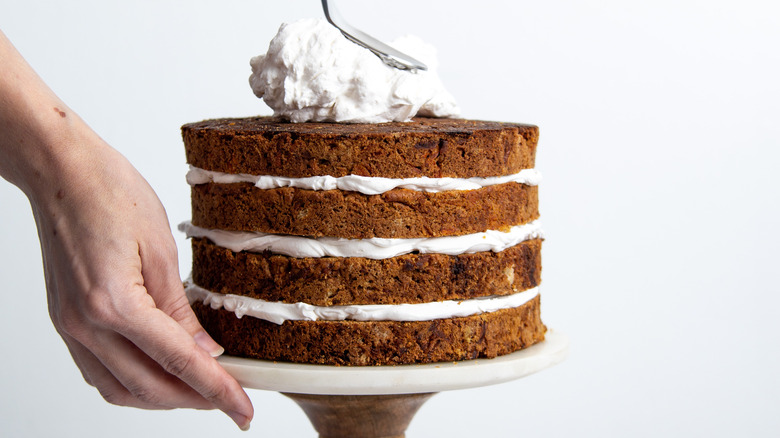The Subtle Difference Between Buttercream And Regular Frosting
What is a layer cake without a sweet outer coating? A sad thing, that's what. There are so many options for finishing a cake — mirror glazes, ganache, royal icing, meringue, and fondant (though a lot of people can't stand it) — and even naked cakes typically contain some frosting. Frosting, of course, is the rich, sugary coating that's by far the most popular choice for cake decorating, and it comes in many variations, including buttercream. This may make you wonder: What is a basic frosting, and how does it differ from buttercream?
The difference between buttercream and a basic frosting is right there in the name: butter. "Regular" frosting (although this is somewhat of an amorphous term) is made using either cream cheese or shortening as a source of fat, and some dessert staples like whipped cream can be used as frosting, also putting them in the non-buttercream frosting category. The main point is that regular frosting typically does not contain any butter. Buttercream, meanwhile, has a depth and fatty richness that you can't get from anything but butter. While butter-filled buttercream may seem like the fancier option, both of these frostings have their place in different cake recipes.
Different kinds of buttercream
Buttercream isn't just plain frosting with butter added to it — there are several subcategories of buttercream that hail from different countries. American buttercream is typically made with just butter and confectioner's sugar, though you can also add eggs or milk. French buttercream is noted for being both extremely rich and very light, since it's beaten until it forms a foamy consistency and uses plenty of egg yolks.
German buttercream (also known as pastry-cream buttercream) is more of a whipped custard that is thickened with a starch like flour or cornstarch. Swiss meringue and Italian meringue buttercreams are two of the most popular types. They're similar, but differ in the cooking process. The base for Swiss meringue buttercream is cooked in a double boiler and adds the butter after the sugar, while Italian meringue combines the butter and sugar at the same time, without using a double boiler. Swiss meringue tends to be silkier, while the Italian style tends to be glossier.
It should be noted that both regular frosting and buttercream are very different from icing. Both buttercream and frosting are designed to stay in a soft state from start to finish, while icing starts as a liquid or near-liquid and is designed to harden as it dries (this is why it's used so frequently as a cookie decoration, in addition to being used on cakes and other desserts).
Buttercream and frosting each have their uses
Should you use regular frosting or buttercream to decorate your cake? It depends on both personal preference as well as what recipe you're making. Buttercream typically has the advantage with flavor, as the butter provides a certain richness; there's a reason why Alice Waters (sometimes called "the mother of American food") once said "Everything is better with butter." And unlike shortening-based frostings, which occasionally suffer from some lumpy textural issues, buttercream tends to be extremely smooth.
For certain recipes, though, you might need the tang of cream cheese frosting. Carrot cake, for example, is rarely made with buttercream; to use anything other than cream cheese frosting would be sacrilege to many bakers. And cream cheese- or shortening-based frostings have another advantage: color. Owing to the butter, buttercream tends to have a slightly yellowish tinge, while other frostings have a neutral white color that's perfect for mixing with food colorings (or using by itself for a pristine snowy look). There are ways to make buttercream appear more white, but it's challenging and not 100% effective.
There are also even more non-buttercream frosting options, such as the aforementioned whipped cream, as well as whipped ganache and so-called seven minute frosting, made with egg whites, sugar syrup, and an acid like cream of tartar. Ultimately, the choice of which frosting to use up to you. Pick whichever one will fit your cake recipe best, and don't feel forced to use a frosting you don't like.


